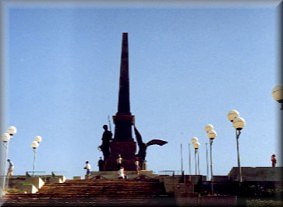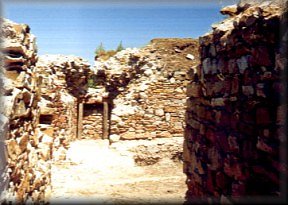
We woke up at 7 o'clock, because
we had to visit the History Museum in Tulcea. We got there and the
museum guide made a detailed presentation of the Roman archeological sites
in Dobrogea.
Next to the museum stands the
monument that represents the union of Dobrogea
with the rest of Romania.

The same day we went to visit Murighiol, where we saw the sites of the Halmyris fortress, about which we'd heard so much at the museum in Tulcea. Halmyris was built in the 1st or 2nd century A.D., and was rebuilt in the 4th century a.d. The diggings started in 1981, and until now were discovered two gates, a thermal building, a building of the military headquarters, and a large building, probably the barrack. We were told that the minister of culture is planning to rebuild the thermal building and make it a tourist attraction.

On the site we met the American EARTHWATCH
team, made up of American history teachers, archeologists and geologists.
EARTHWATCH is an organization that tries to preserve the Roman sites
all over the world and that finances the diggings in Halmyris. They said
that Romania has the most Roman sites in all Europe, after Italy, which
we noticed at the end of the trip. They were very impressed by our interest
(although at the beginning we only looked interested) and invited
us the next day to join them at the Argamum fortress.
All this time we were guided by
Mr. Zahariade, a specialist in Tracian archaeology, who also teaches at
the Archeology University, and he told us many things about this fortress.
After it had been under Roman occupation for 7 years, Halmyris was
abandoned in the 8th century A.D., when the slavs conquered
the frontier.
After this long exhausting day
we finally returned to camp Bididia.